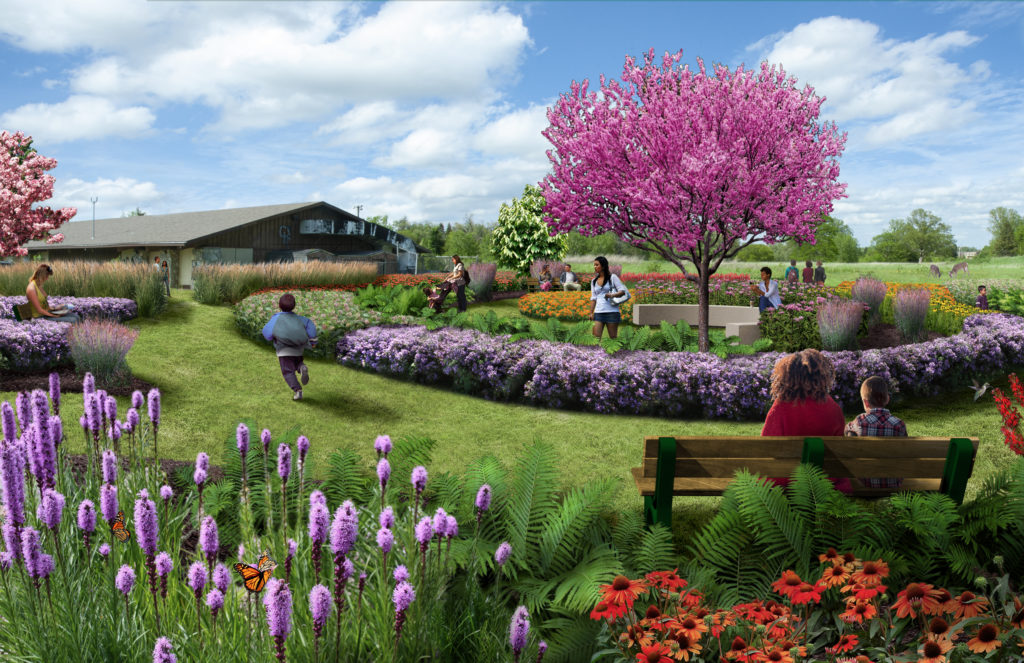By Melodee Mabbitt
When Desiree Duell’s parents divorced, they sent her to weekend classes at the Flint Institute of Arts. It was there she learned that art could be very therapeutic.
Now living and working in the College and Cultural Neighborhood, Duell’s latest art seeks to help everyone in Flint heal from the water crisis, as well as other environmental injustices and longstanding socioeconomic and racial inequalities she sees in the city.
Her latest work, Sanctuary, is underway on Flint-owned land that previously was the nine-hole Pierce Park Golf Club. There, Duell worked with neighbors to begin a therapeutic garden and host healing-themed events, with a long-term vision of building a “restorative justice ecosystem that will reclaim urban land to transform it into a refuge to grow, harvest, and teach indigenous plant medicine.”
Indigenous plant medicine uses native plants to heal the body, but to understand the rest of Sanctuary’s mission, one needs to understand Duell’s strong beliefs about public art and how artists can include communities to heal through creative work.

Proposed plan for the Pierce Park “Sanctuary” Alexi Logothetis rendered this map of Sanctuary garden’s Michigan-native plants, funded by a grant from the Michigan Wildflower Association.
While studying for her Master of Fine Arts degree from the University of Hartford, Duell read a lot about social justice, environmental justice, and poverty. She cares deeply about mental health struggles and how they are shaped by these social systems and the resulting environments.
An article about “sick woman theory” particularly influenced her, she said, because it argued that care work could be a form of protest for people suffering from oppression.
Duell said she sees the therapeutic garden as an emergence of the communities’ efforts to heal together by caring for ourselves and the land.
“Self-care is often centered on the individual, but we also need self-care as a community,” she said. “This is a communal approach to self-care. By coming together to slowly grow and care for the land, we’ll slowly learn to grow and care for ourselves, each other, and gain our agency over our environment as a community.”
To begin the project, Duell obtained a letter of support from the College and Cultural Neighborhood Association and a letter of permission from the Flint Department of Parks and Recreation. She also won a grant from the Michigan Wildflower Association for $800, with the Genesee Conservation District acting as fiduciary partner. She then adopted the park through a program at Keep Genesee County Beautiful.

How it could look: image rendered by Alexi Logothetis of Sanctuary’s garden.
Practical work started in May when Duell received help from the Neighborhood Engagement Hub to remove brambles from the old bowling lawn behind the clubhouse building in Pierce Park. Volunteers were organized by Rebecca Pettengill, who also lives in the CCN. Neighbors then covered areas of the ground to solarize the soil to clear weeds for planting next spring.
Ongoing activities in the park include a drumming circle at 7 p.m. every other Wednesday facilitated by Carl Rogers, and Thai Chi and self-defense workshops by Dawei Li on alternating Wednesdays at 6:30 p.m.
In the fall, Duell and Pettengill will host “The Art of Gathering” that will include workshops to make a piece of community land art while exploring how to shape community rituals.
According to Duell, the next phase of work will include an environmental assessment to test the soil, determine what the natural landscape was prior to becoming a golf course, and begin a conversation that Duell hopes will allow neighbors restore the land in harmony with the natural landscape.
“It is possible that this land could have been wetlands or that there is an artesian spring here,” Duell said. “We want to do a comprehensive plan for how to develop the park with involvement from everyone in the community.”
In the long-term, Duell hopes Sanctuary can use the clubhouse for a community kitchen for drying herbs, holding classes, or creating retail space.
“We’re often so stressed that it can be hard even to just be nice to each other,” Duell said. “I want Sanctuary to give us the agency to heal ourselves and heal the land so we’re not completely dependent on the civic infrastructure that poisoned us.”
More information about Sanctuary is available by emailing Duell at desiree.duell@gmail.com or following the Sanctuary-Art Park page on Facebook.
Banner image: rendering by Alexi Logothetis
EVM Staff Writer Melodee Mabbitt can be reached at melodee.mabbitt@gmail.com.


You must be logged in to post a comment.